Students visited 16 laboratories of Faculty of Science, Faculty of Education, Faculty of Engineering, Faculty of Collaborative Regional Innovation, Faculty of Agriculture, Faculty of Medicine, Proteo Science Center, Academic Support center, and Center for Marine Environmental Studies at Ehime University on the afternoon of 23rd and 24th October.
First and second graders in the science course participated in lectures at each laboratory and conducted experiments, went out for field works, made an observation, programmed, and so on. Although it was a short period of time, these experiences were good stimulus for students.
(207HR John Does)
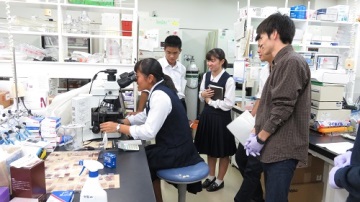
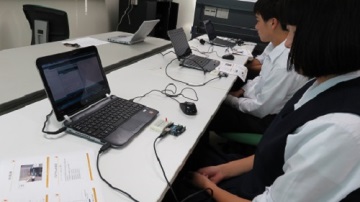
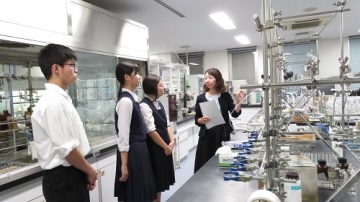
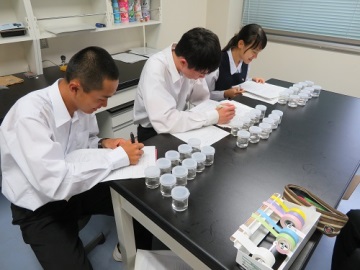

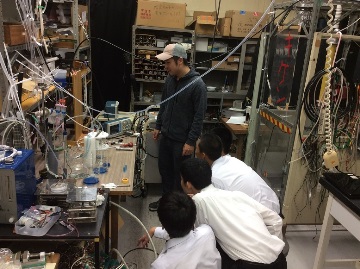
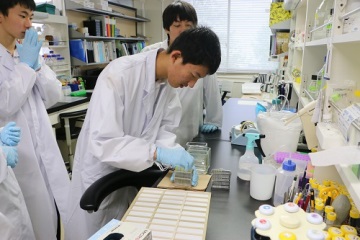
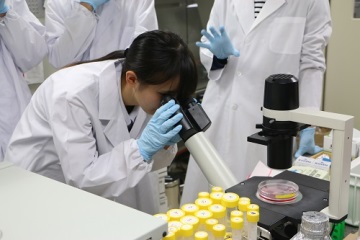
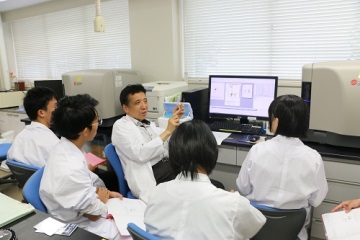
On September 26th, Super Science for first and second graders in the science course was a collaboration study with Ehime University. They visited the faculty of science. First graders study chemistry and geoscience. Second graders study medicine, engineering, and agriculture. They took the lectures and participated in the facility tours. Students felt professors’ passion for their research. I would like them to make use of these experiences for future research activities.
【Second graders : Medical group】
We took the lecture, “cell memories and induced pluripotent stem cells” in the basic medicine class (Professor Kato Hidemasa) and studied research results and problems of the high pediatric in the lecture of clinical medicine. We took the high-quality lectures at Ehime University, so we want to study more at the university.
In addition, at the laboratory of molecular parasitology we watched malaria infecting a red blood cell of the mouse.
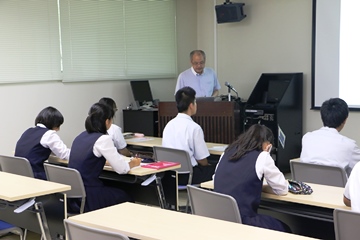 The lecture of basic medicine
The lecture of basic medicine
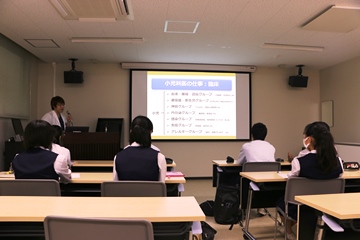 The lecture of clinical medicine
The lecture of clinical medicine
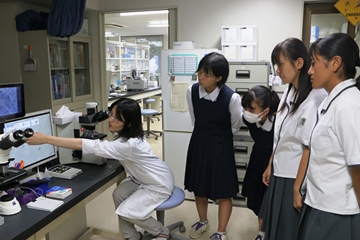 The laboratory of molecular parasitology
The laboratory of molecular parasitology
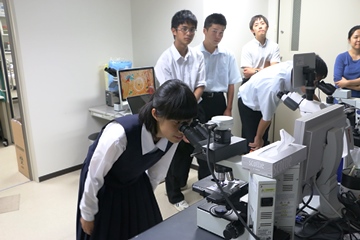 Observation of malaria
Observation of malaria
【Second graders : Engineering group】
We studied theoretical and technical breakthrough points until the realization of a manned airplane. The lecture was “Why does an airplane fly?” given by Associate professor Iwamoto Koji, a member of mechanical engineering course, the faculty of engineering.
In the lecture of the theory that an airplane flies, we used hydrodynamics and dynamics that we learned at high school. Through the experiment of the paper airplane, we understood and deepen the theory for a stable flight.
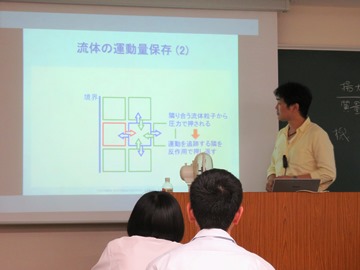
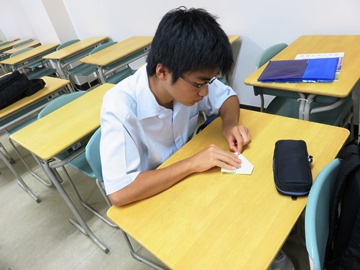

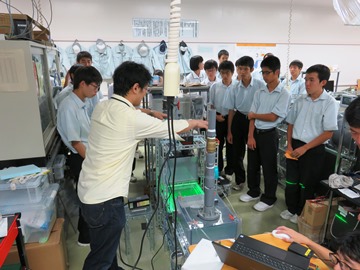
【Second graders : Agriculture group】
We visited the plant factory after the lecture, “Speaking-Plant-Approach technology enables us to do smart agriculture” given by Professor Takayama Kotaro at the graduate school of agriculture. They studied the feature of light and photosynthesis. We also studid the principal of diagnosing crop growth with light and the importance of cultivation management and collecting various information. In the plant factory we watched a measurement robot and saw planted tomatoes. Moreover we had a Q&A session. Thank you, Professor Takayama and lab members.
 The lecture
The lecture
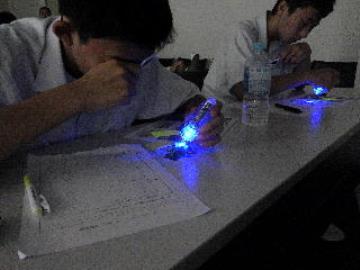 Observing chlorophyll of a leaf
Observing chlorophyll of a leaf
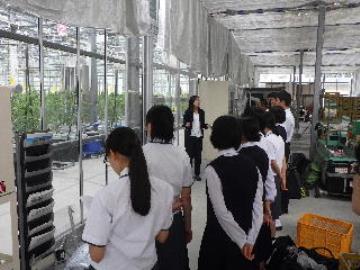 The plant factory tour
The plant factory tour
【First graders : Chemistry group】
Professor Kunimatsu Tatsuya, a member of the chemistry course in the faculty of science, taught us endocrine disruptor in the lecture of environmental science. Various substances existing in the environment remain in living things on the earth. We also learned that we are affected by eating them. When we burn garbage, such substances are exhausted and pollute humans especially in developing countries. Therefore, it is necessary to solve the problems of garbage. We have to gain correct knowledge to prevent us from being polluted by chemicals. We should use eco-friendly materials, too.
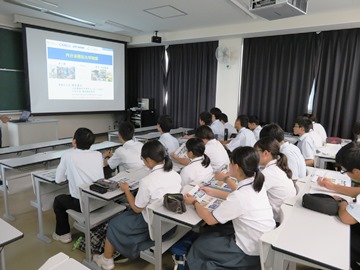
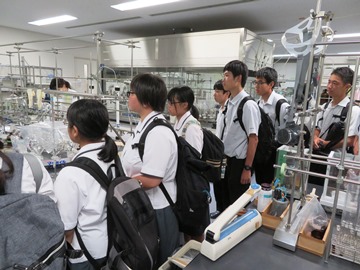
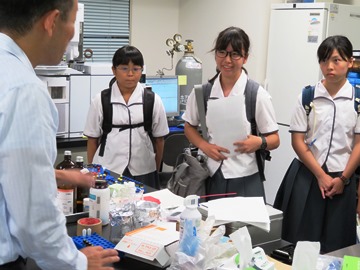
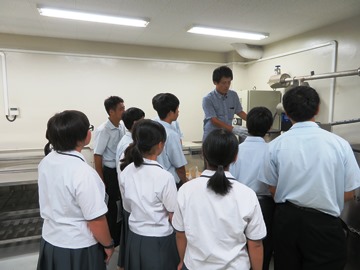
【First graders : Geoscience group】
Professor Kameyama Masanori and Professor Idekura Haruhiko, who are members of Geodynamics Research Center, gave us a lecture on a state of the earth interior from a macro and micro-view points. Even if it is an invisible and the place where we are not able to go, we can learn the states of it using physics. We felt that researching spirit of “I want to know.” is the origin of a study. In addition, we observed the laboratory after the lecture. We watched an extra-high-voltage power device and hime-diamond with our eyes shining.
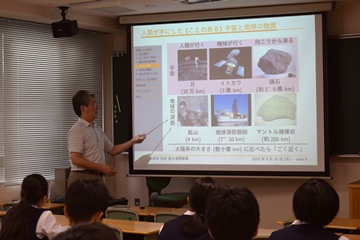
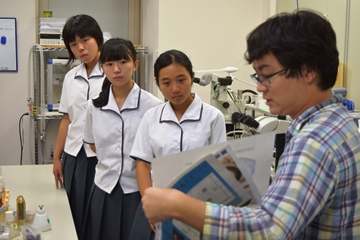
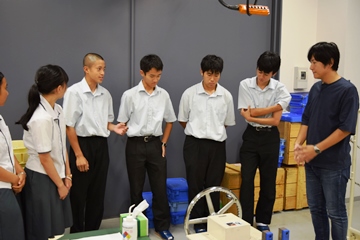
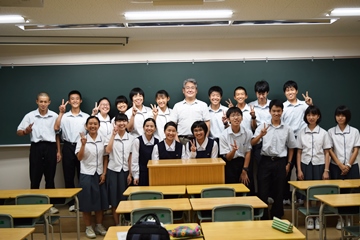
(207HR S.I, S.U, R.T, M.O)
One of the students in the science course took part in the first Tokyo University GSC. At first, she recieved a guidance. It was about the purpose of the GSC and the schedule. Then she took a lecture, “Introduction to Statistics for Scientific Study” by Hejcik Pavel, an assistant professor. She studied the data analysis more deeply than she had studied at her school. She wants to work on the assignment until the next GSC.
(207HR Yokoyama, Yamamoto, Nakano, Nagao)
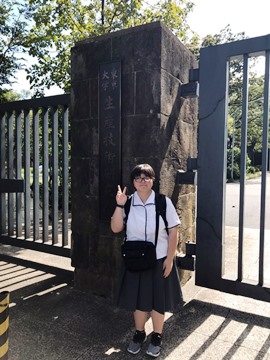 She stood in front of the gate at Tokyo University.
She stood in front of the gate at Tokyo University.
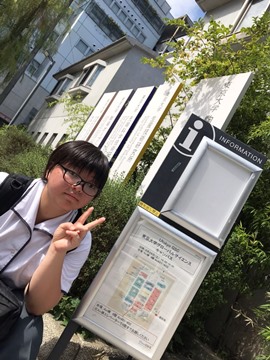 The building where she took the lecture.
The building where she took the lecture.
Fujiie Ai, a second year student in the science course, joins Global Science Camp (GSC) Hiroshima step up stage. She participated in the fieldwork in Taiwan from September 9th (Mon) to 11th (Wed). The following is her report about the fieldwork.
I joined the fieldwork in Taiwan, one of the activities of GSC Hiroshima. Two girl students who live in Hiroshima and I joined it. We only transported on the first day. I left for Matsuyama airport in Taiwan from Matsuyama airport in Ehime. I joined two girls on the way. The typhoon delayed our transfer. However we safely arrived at Taipei. After arriving there, we left for Yilan. I visited Taiwan on my school trip in May. So I felt nostalgic about the unique smell like Taipei. But the atmosphere there was different from that of Taipei.
Second day, we visited National Lan-Yang Girls’ Senior High School. I made a presentation about glaze of Tobe-yaki I study. It was my first presentation in English. So I was very nervous. The students there enjoyed not only their studies but their presentations. This experience inspired me very much. After that, we enjoyed English class and took various scientific seminars mixed with art.
When I joined group activities, I was a little bit overwhelmed by their English skills. However, I used English as much as I can and gestures to have a good communication with them. Thanks to it, I made many friends. I realized my week points of English. I want to continue studying hard.
Third day was a homecoming day. We had a frightening experience. The plane we boarded tried to land on Haneda airport again and again. However, I finally arrived at Matsuyama safely. I had a lot of experiences. I deepened bonds with friends, met “Rike-jo” in Taiwan , and so on. I want to spend my school life happily and study hard.
I thanked my teachers in Hiroshima. They guided me during the fieldwork in Taiwan.
The report of this fieldwork is on the website of Hiroshima University,
“GSC Hiroshima” https://www.hiroshima-u.ac.jp/gsc/2019t
(207HR Morino Kouki)

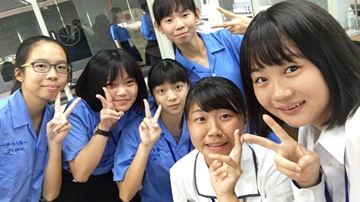
Last year, the students of Tobe branch school made a broach using the glaze which Icho (ginkgo in English)-girls made with leaves of ginkgo trees in Matsuyama Minami High School. When they sold the broaches in their school festival, they received a high evaluation! (There is a picture below.)
By the way, this year Ume (plum in English)-chans are going to produce a small dish with the glaze made from branches of Nanaore plums in Tobe Town. The other day, the first trial products were made by Ume-chans. They used small unglazed pots made by students of Tobe branch school. By using ash (burned plums) containing iron, they made a green glaze. When they mixed it with feldspar, its color turns into white. They will continue making pots with this glaze, making improvements of it.
Although the report of Ume-chans has been stopped temporarily, their research is going well. I am planning to report it again. And they want to make not only the glaze that Icho-girls and Ume-chans hope but also the glaze that students of Tobe branch school want to use.
They will try to make fascinating “Tobe-yaki.” They would like to ask continued support. They are going to sell their small dishes in the school festival of Tobe branch high school on Saturday, November 9th. Please look forward to seeing their dishes then. (201HR H.Y.)
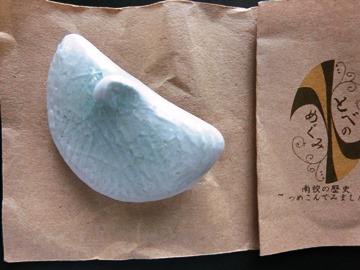

Presentation Meeting for Science and Mathematics Course Students of High School in Chugoku, Shikoku, and Kyushu district
Our students participated in Presentation Meeting for Science and Mathematics Course Students of High School in Chugoku, Shikoku, and Kyushu district on Monday, August 19th and Tuesday, 20th. At Yamaguchi Health Promotion Center, 16 stage presentations and 50 poster presentations were given by students of science and mathematics courses in Chugoku, Shikoku, and Kyushu district.
Third graders who belongs to “Vitamin C,” “pollen fossils,” and “mathematics” group gave poster presentations from our school.
On the first day, they gave poster presentations including a judge. Our students did well in the long work of an hour and thirty minutes
On the second day, they were very motivated and raised their hands to ask questions as one of the audience.
The mathematics group won the best prize. Everyone worked hard despite of the tight schedule.
(201HR A.D. , M.T., A.M., N.W.)


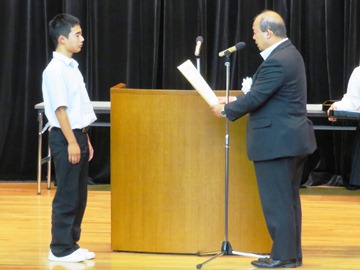

On the return day, I left the hotel at 5am and headed to the airport. At first, there was a small problem when I left my luggage, but I managed to get on the plane. However, even after 1 hour, the plane did not fly, and after a while, an announcement that “departure was delayed” flowed and was got off from the plane. I thought I will miss the connecting flight, so I asked the staff, but it was a very cold reply. I felt the greatness of the Japanese airline.
After all, because of bad weather in Chicago, there was only one late flight that day, but I was not allowed to ride it. However, it is a big trouble that only the baggage goes to Chicago due to the mistake of the airline. I couldn't return to Japan on that day, and I stayed at Dr. Mani’s house that night.
The next day, I left home early in the morning and headed for Chicago from Hartford. I was able to get on the plane safely. There was no check between the international and domestic flights at the Chicago airport connection, it was free to come and go, and there was no customs and no passport check.
This time, I was able to leave Chicago and arrive safely in Japan without getting in trouble. Thanks to Dr. Mani’s wife’s negotiating with the airport staff, I was able to pick up my baggage at Narita Airport.
The first thing I felt when I came back to Japan is that it is delicious whatever I eat. I thought I had a strange taste. All American foods have high calories and the tastes are quite different from those in Japan. I felt that I spent about 40 days in such a situation.
Recalling that now, it seemed like a long time, but it was not true and s short time. I am very grateful to all the people for their cooperation in various aspects including Dr. Mani. I would also like to share my valuable experience with many people.
(309HR Ikeda Yumeka)
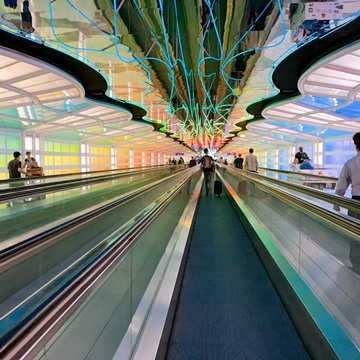
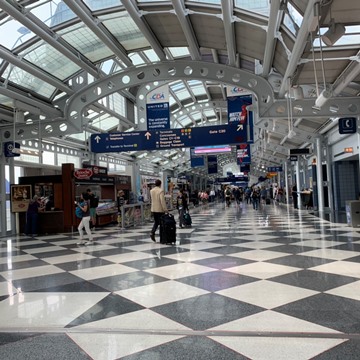 Chicago Airport
Chicago Airport
This week, I visited the laboratory at the Department of Chemistry at the University of Connecticut, where Dr. Tomoyasu Mani, a first-year graduated student of SSH works. I made the D-A (donor acceptor) molecule based on BODIPY (boron-dipyrromethene: a type of fluorescent dye) using the Suzuki Coupling method. I used Rotary evaporator and Column chromatography in this experiment, and I was surprised to find so many experimental instruments that I had never seen before. But I was more surprised. In the United States, it is thrown away when the test tube and the pipette etc. are used only once. I thought it was unthinkable in Japan.
I study for about six hours every day, but I feel that time passes very quickly, and I spend a fulfilling life.
Until last week, I was living in a university dormitory, but this week I'm living in a hotel in the university. The hotel has a swimming pool, and of course all TV programs are in English, so it's also a good way to learn listening. A lot of Japanese anime is broadcast in English. I went to the supermarket. There were many types for each food.
*The Suzuki reaction is an organic reaction, classified as a cross-coupling reaction, where the coupling partners are a boronic acid and an organohalide catalyzed by palladium complex. It was awarded the Nobel Prize in Chemistry by Akira Suzuki in 2010.
(309HR Ikeda Yumeka)
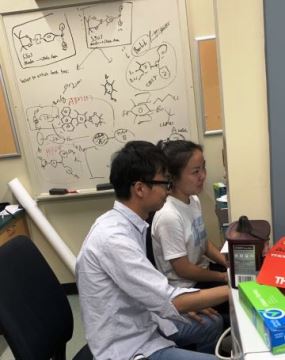 Studying with Dr. Mani
Studying with Dr. Mani
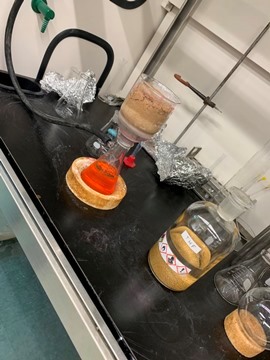 Experiment
Experiment
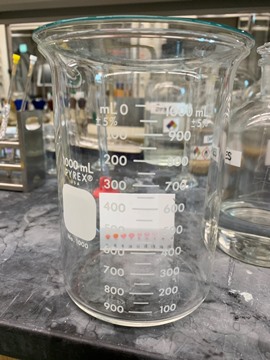 TLC
TLC
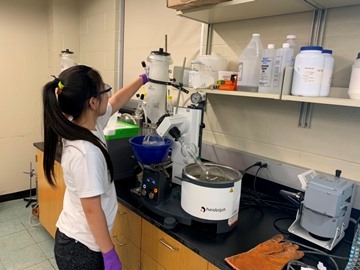 Rotary Evaporator
Rotary Evaporator
On Wednesday July 31, the elimination round of “Sugaku Koshien 2019” was held in Okayama. 3 teams (second and third graders of the general and the science course, 12 students in total) participated in it. The whole country was divided into 12 blocks and our prefecture, Ehime belongs to “Chugoku Shikoku block.” Sugaku Koshien 2019 is the 12th. The number of participants are increasing rapidly for this 10 years. More than 200 students participated in this event this year. It was really got lively. In the heat our school’s mathematical elites worked on the difficult problems and did their best. We hope that students will make use of this experience and keep up their interest in mathematics from now on.
(204HR Nishiyama Terumi, HIgashiura Nene)
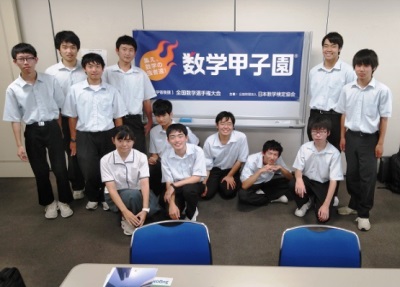
I chose “Food Science and Technology” for the second week. This lesson were classroom learning, but we went to the Lab to do experiments on Tuesday and Wednesday afternoon.
In the lecture we learned science technology, which is in the background of food, and considered how to choose healthy food. In the experiment, we measured pH of purple cabbage. Then we made ice cream, cheese and butter.
When I had a conversation with my classmates, I was asked a lot of questions about Japanese food. We had a great talk!
I took five lectures. I enjoyed “Pharmacy Compounding Workshop” the best. We compounded materials, dispensed medicine and put it into a container. Then we wrote a patient’s name on it. I could experience medicine manufacturing.
We changed our roommates every week. I shared the room with a student from Massachusetts. She was very friendly and kind. We had a lot of conversations and joined the activities together. I introduced origami to her and folded it together.
This week, I asked people around me to speak slowly because I learned from mistakes last week. Then everyone told me meanings of English words in conversation and rephrased what they said as easily as possible. So we had a nice chat and it was connected to learn new things. In group chatting with new friends, I learned unique expressions and abbreviations which are used in America.
I also learned a lot about American culture and tried to have American food and drink. I surprised at the pizza shop in Storrs Center which I visited in the activity class. Surprisingly, I could choose topping ingredients and pizza dough I like. They were so delicious!
I’ll take “Digital Animation and Motion Graphic” class next week.
(206HR Jane Does)
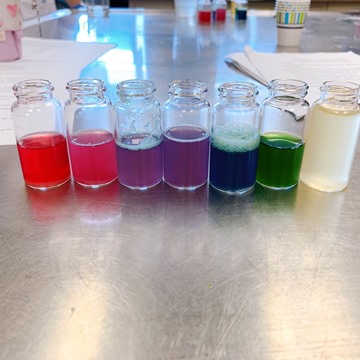 Measurement of pH
Measurement of pH
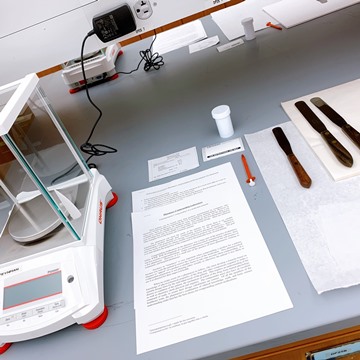 Dispense medicines
Dispense medicines
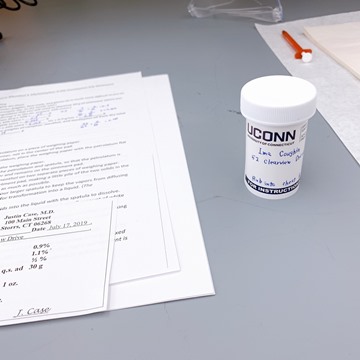 Put medicine into a plastic case
Put medicine into a plastic case
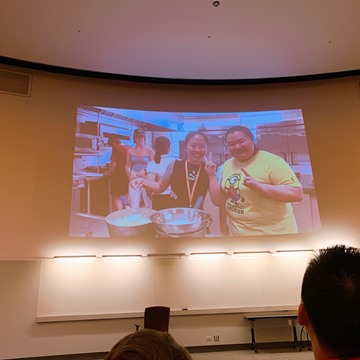 In the closing ceremony(The picture was taken when we made cheese)
In the closing ceremony(The picture was taken when we made cheese)
In the first period, Challenge ResearchⅠ, freshmen of the general course held review meetings about their research questions. All the students from 101HR to 108HR were divided into groups by field. Each group gathered in the same place and considered research questions and study methods. They also received advice from teachers who major in those fields. Teachers who teach different-grade students took part in the meeting. They were able to review their research from the different point of view. Now they will work on research activities in earnest.
(John Does & K 206HR)
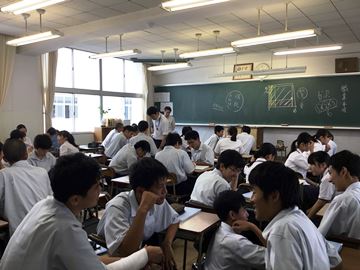
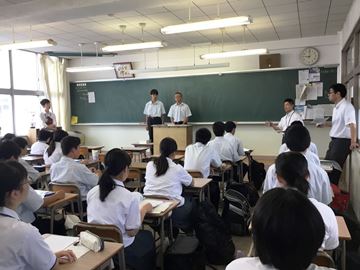
Ikeda Yumeka, who is a third year students of science course, was selected a member of “Tobitate!” Leap for Tomorrow, Young Ambassador Program. This program is sponsored by Ministry of Education, Culture, Sports, Science and Technology. She is now taking a training for about six weeks in Connecticut, the United States of America. We’ll inform you of her report from Connecticut!
I left Narita Airport on Saturday, July 6th and arrived at Hartford via Washington. There is a thirteen-hour time difference between Connecticut and Japan. So my days and nights were reversed and I suffered from jet lag at first. The sunlight is strong outside and it is very hot! But the air conditioners is so strong in the room that I feel cold although I wear a long-sleeved shirt.
Now I join “U Conn Pre-College Summer.” I live in a room in the dormitory. I have to change my room and my roommate every week. My first roommate was a local student. The school cafeteria is buffet style. They serves typical American meals, so I miss Japanese food so much!
For the first week I chose a “Data Science” class. I attended an orientation on Sunday and took classes and workshops on Monday, Wednesday, and Friday. I took classes all day on Tuesday and Thursday. After dinner we have some activities every day.
There were many discoveries and surprises this week! Participants are almost local students. Of course I am the only Japanese. I know it’s only natural but I’m surprised that they speak English very quickly. I ask them to repeat what they said once more because I can’t catch English. When I talk with few students, I can easily asked them to do so. But I have difficulty asking them during a class. However, whenever I’m in trouble, I was helped by my classmates sitting near me so many times.
In a “Data Science” class, I calculated “cosine similarity,” an index number that shows similarity of multiple documents. I had difficulty in typing in a unique way. Of course, I type words in Japanese and others in English. My teacher borrowed me a PC and people around me helped me. I managed to do my best. I finished making a presentation without any troubles on Friday. Then I finished all the classes of the week. On Saturday I went to a field trip.
Next week I’m going to take a “Food Science and Technology” class. The campus is so big that I’m almost getting lost. I came across beavers and deer while I was walking there. Connecticut has a good environment because it has a lot of nature.
(John Does 206HR)
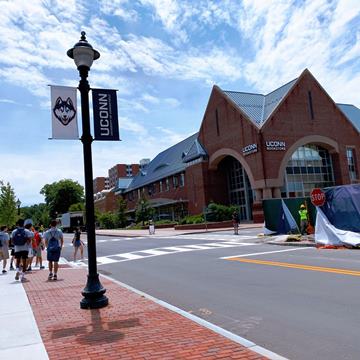
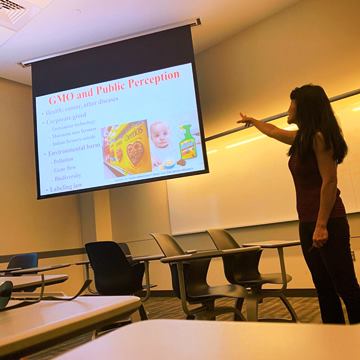
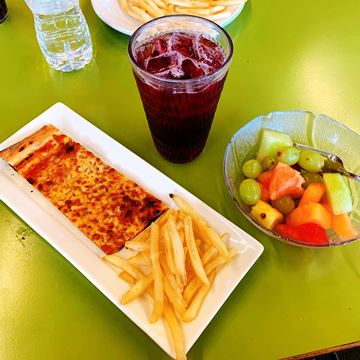
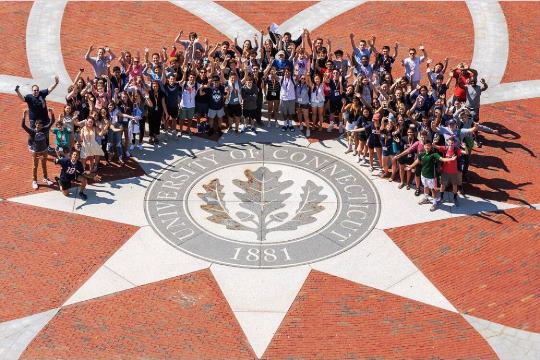
A second year student who belongs to the science course in our school left for Taiwan to take part in The 2019 Asia-Pacific Forum for Science Talented.
The representatives of junior and senior high schools in sixteen Asia-Pacific countries met in Taiwan for the forum. The purpose of this forum is training them to demonstrate leadership to play an active part in the international community through discussing, making some projects and presentations, doing fieldwork about scientific contents and cultural visit.
Six students join this forum from Japan. They are from Ehime University Senior High School, Okinawa prefectural Kyuyo High School, Koyo High School, and our high school.
On Saturday, July 6th, members of Team Ehime left Matsuyama airport for Taiwan via Haneda airport. Although their arrival at Taipei was late and behind the original schedule, they managed to reach their destination and met Team Okinawa.
On Sunday, July 7th, the opening ceremony was held and each country showed their performance. All the members from Japan wore Yukata and introduced Japanese culture.
After that, they danced with “Fortune Cookie in Love” by AKB 48. The students from other countries got on the stage and were really excited.
They are starting Hands-on-Project from tomorrow.
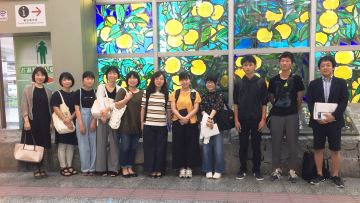 Before Departure with Their Parents
Before Departure with Their Parents
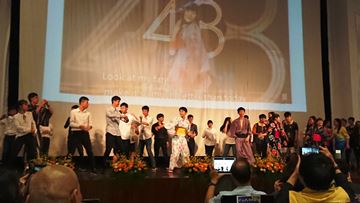 Very Exciting Stage!
Very Exciting Stage!
On June ninth, GSC Hiroshima Pop Stage second seminar was held. Our students took three lectures, “Scientific literacy,” “Researchers’ ethics,” and “Scientific lecture meeting.” Lectures are deep and interesting with active learning. It was stimulating day for them. Now they start writing reports hard!
(Yamamoto Daichi 203HR)
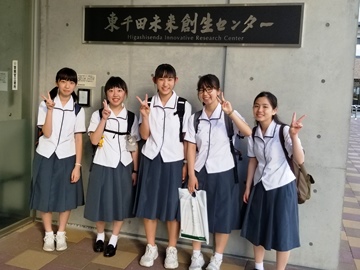
Today First graders’ CR was held as a part of “diagnosis of basic academic skills for high school students.” Mr. Maeda, a staff of Benesse Corporation, came to our school. Students reviewed their results of academic ability research that was held soon after their entering high school. Also, Mr. Maeda proposed specific plans to improve their ways of studying.
They were grateful to Mr. Maeda for his lecture!
( T.M. 203HR)
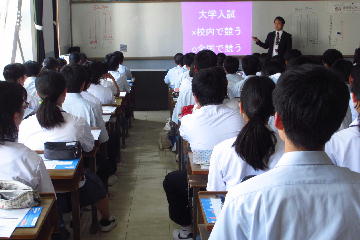

SC of this year started today. The first graders of the science course performed basic experiments of science every Wednesday after school. They do experiments and practice with university students and graduate students. They also worked on training to do advanced research of SS. In biological section, we practiced the basic operation of a microscope and the handling of a micrometer today. That’s science course students! They operate microscopes very quickly! (John Does 209HR)
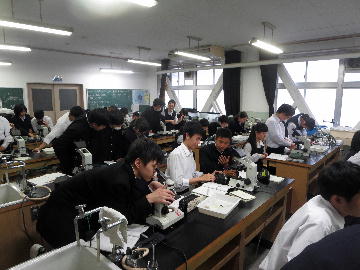 They were working together.
They were working together.
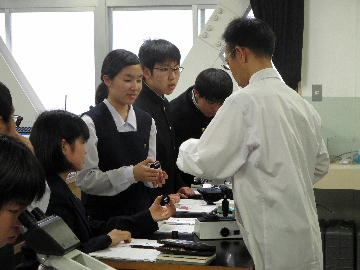 A trouble with the microscope?
A trouble with the microscope?
Nadano, Ono, and Yamazaki (members of the math group, 309HR) won the Fighting-Spirit Prize, which is comparable to quarterfinals, in the 8th Sports Data Analysis Competition (Japan statistic association sports statistics subcommittee).
They analyzed victories and defeats of Hiroshima, Kyojin, and Yacult games in 2017 by using evaluation index of pitchers of major leagues.
They said, “We were busy conducting this analysis and ‘Effectives of Tie Break’, our super science research, at the same time. However, we were able to make a good poster. We would like to apply for a lot of contests in the future.
(Jane Does 205HR)
Kimura Nagi (209HR) participated in GSC (Global Science Campus) Hiroshima Jump Stage workshop. She advanced the final stage which was held by Hiroshima University. Fifteen students were selected from more than 300 students. She was selected one of the members. She is going to start her research with professors of Hiroshima University. She has a chance to make a presentation of her research in Australia. She talked about her way of research and plans with professors. They exchanged ideas positively. We are looking forward to the research.
(John Does 205 HR)
Our school held SDGs meeting at Nanpu-kan building in Matsuyama Minami high School. Participants actively exchanged ideas about making sustainable towns. Three students of science course took part in this event. They gave presentations and joined workshop. Now, SDGs improves various works in the world. Each people can continue doing something to achieve goals. Let’s get interested in SDGs and you can do something.
<Participating high school >
Ehime Prefectural Saijyo High School .
Ehime Prefectural Imabari High School.
Ehime Prefectural Matsuyama Higashi High School.
Ehime Prefectural Matsuyama Minami High School.
<Lecturer>
Kobayashi Osamu; associate professor of Ehime University
(Institute for international relations)
Ms. Takeuchi Yoshiko; representative director of Ehime Global Network
<Other participating group>
Shikoku EPO・Matsuyama city, general policy department・Kumakogen town chiiki-okoshi group
Workshop


Giving the presentation

We received a message that they arrived at John F, Kennedy International Airport safely. America is 14 hours behind Japan. It had been -17℃ and cold until last week but it is warm today. After the arrival, they are going to University of Connecticut where Tomoyasu Mani, who is our school’s SSH first graduate, works now.


Five students of second graders took part in SSH overseas program in America. They left Matsuyama airport on February forth (Monday). Today, they fly to JF Kennedy airport via Haneda airport. They are going to meet the senior, a graduate of the first SSH who works at University of Connecticut. Also, they visit three high schools and research institutes. It will be a long stay of 6 days and 4 nights, but every day they will do their best. (by TOMONORI)


We have advanced to the top 4 of the national convention’s idea contest to make regions innovative in 2018.
Our high school’s second-year students, Daigo Shiraishi, Sodai Takada and Yuki Takeda studied their region, and then they were selected as the top 4 of the idea contest of policy to make regions innovative in the high school student’s category. After that, they participated in the final examination conference, which was held in the Cabinet Office Central Government Building on December 15th, 2018. As a result, they couldn’t win the top award but they won award of True Date Award. Their results were so wonderful.
Finally, we express gratitude to the members who work at IRC and associate professor Tetsuto Himeno of Shiga University. (Fuko Sadamatsu, Nanami Matsumoto, Yu Tamura)








Everyone came back from a three-day short trip from Kansai. On the third day, we learned two things. First, we took a special course by associate professor Takeo Yamauchi of University of Hyogo at The Museum of Nature and Human Activities, Hyogo prefecture. We learned about pests and infection, mainly about mosquitos and ticks. We gained a wonderful sense of fulfillment through observation of specimen and the specimen room. Second, in Harima science park city, we visited exhibitions about the radiation facility “Spring 8” and “SACLA”, science and chemistry laboratory, famous buildings and a solar power facility made of more 12,000 panels. We were touched by all of them. We can think about what we can do to develop sustainable society and what society and environment should be like through three days. I want to make the most of the experience for their research and their future career. (John Doe)



Custom-made seminars: The relationship between urban harmful creatures and us
Museum of Nature and Human Activities, Hyogo: Takeo Yamauchi associate professor/University of Hyogo



(Harima Science Garden City)
All members are learning well. The following is the contents of this seminar on the second day. In Kyoto University, some students began to choose the university as the first candidate university after their visit. In JT Biohistory Research Hall, they learned the history of creatures and the importance of living with other creatures. At a night seminar, they considered about ESD(Education for Sustainable Development), which is the theme of this training seriously through hands-on learning, and planned new behavioral goal. On the third day, we will study in Museum of Nature and Human Activities, Hyogo and Harima Science Garden City. (Yudai Iwaki, Syunzi Ono, Kengo Murofushi)


Visit the Kyoto University Yoshida Campus, The Kyoto University Museum


JT Biology Research Hall


ESD Study
Today was the last day of SS class. The second-year high school students start to compile their study. There are some groups that start consolidating data and making a poster to make a presentation at January and February. The group, which carried out some experiment, is ina final stage, too. Finally, further effort will bear fruit for them. The first-year high schoolstudents went to Kansai to attend a learing seminar now. They will learn a lot. (John Doe)


Ginkgo group was researching purple glaze by using ginkgo. At last, we got a kind of purple color. There are two kinds of group, which are divided by the difference of color. Those colors are purple and reddish purple. We will announce the detail of our research soon. Our study still continues.
Thanks to a lot of basic researches, we got the result like this.
From now on, please enjoy the research result. (John Doe)


Cooperation between High Schools andUniversities project electromagnetic induction andsuperconduction. On Thursday, November 8, Science coursestudents (first graders) had a class with a professor of Ehime University in thephysics second laboratory. We invited Mr. Kamimori Tatsuo, a professorof Ehime University graduate school of science and engineering. Students had a lecture and did an experiment. The professor explained phenomenon causedby electromagnetic induction and eddy current. He also explained principles of electromagneticinduction by Faraday. After thatstudents examined the condition of the turn of an aluminum board by eddycurrent and falls of magnets. Next, the professor explained a superconductingphenomenon and cooled a superconducting substance with liquid nitrogen. When students confirmed a superconductingcondition, shouts of surprise broke out everywhere. After the lecture they asked Prof. Kamimorimany questions. It seemed that they feltgreat interest in his lecture. Thank you for Prof. Kamimori. (O.H.)


Tobeyaki-umechans, who study NanaoreUme ( aplum ), went to Tobe town to collect leaves for material of their study.
They cooperated with Youji Higashi, therepresentative director of Nanaore Ume Plum Cooperative Association, and MasaruTakeuchi, the processing and selling manager. They gathered the green leavesremaining in the trees.
It cannot be said that leaves aresufficient amount. We dry them and burnthem to cinders.
I’m looking forward to seeing what kind ofglaze it will be! (Inoue Hiroaki)




Tobe-yakiUmechans finish making the ash of plums. Theyworked very hard. They completed test pieces with the cooperation of Karasudani-sensei,a teacher of Tobe branch school. Interestingly, themixture of Fukushima feldspar (20%) and the ash (80%) developed the strongestcolor and there was no effective color development with only the ash. Inaddition, when they covered a test piece with transparent glaze, the colordisappeared after it was baked. They try to analyze ingredients and make a mechanismof plum’s coloring clear, comparing with coloring of ginkgo leaves. (T.Y)


Today we had the 14th SS. Second graders’ challenge researches are makingprogress very well. They got advice fromgraduate students of Ehime University and many other people. They search for better research contents. We are looking forward to seeing how far theirresearches will develop in the remaining period. (Y.T)

Graduate students of Ehime University helpthem.


She’s used to separating substancesby a centrifuge.

They can also measure oxygen concentrationvery well.

Mathematic team is reviewing theirdata.
On October 24 (Wednesday) and 25th (Thursday), a second grade mathematical science student visited the laboratory of Ehime University. Visiting places are Faculty of Education, Faculty of Science, Faculty of Engineering, Faculty of Agriculture, School of Medicine, Proteoscience Center, Coastal Environmental Science Research Center, Deep Earth Dynamics Research Center.I will introduce a part of that situation. Every laboratory has prepared highly sophisticated and specialized lectures, practical training, and experiments that can not be experienced in high school life, and gave me a very valuable experience. Thank you very much for each of our laboratories. Thank you very much!
Faculty of Agriculture


School of Medicine


Faculty of Education

Coastal Environmental Science Research Center

Today 's SS was the 13 th this year.
Since second graders were a high school collaborative project, there were an activity of only the first graders. Issues There are explanations of the research schedule, how to plan and efficiently conduct experiments and observations with little activity time and scientifically summarize it? The ability of each team is questioned.
 Experiment preparation of osmotic pressure of glucose
Experiment preparation of osmotic pressure of glucose
 They carefully plan the experimental plan
They carefully plan the experimental plan
Today 's SS was the first semester and the ninth this year.
Second graders continues to work on problem research. In the second semester, there are also intermediate presentations and presentations at Kobunsai Festival, and it is around time that the pace is rising. Based on the results of the experiment, let's set the direction for further research progress.
First graders decided the theme of task research and planning research plans. Although it is the start of research, planning the first plan is important. Please consult with your teacher well and let's move forward after making a prospect.

What to do with tomatoes ...

Preparing for electrolysis

They also cooperate to measure the frictional force

They received a research lecture from their senior
They are leaving Matsuyama airport
They Arrived at John F. Kennedy International Airport.
They have just done the check-in procedure.
In front of the Halloween pumpkins at the supermarket near their hotel.